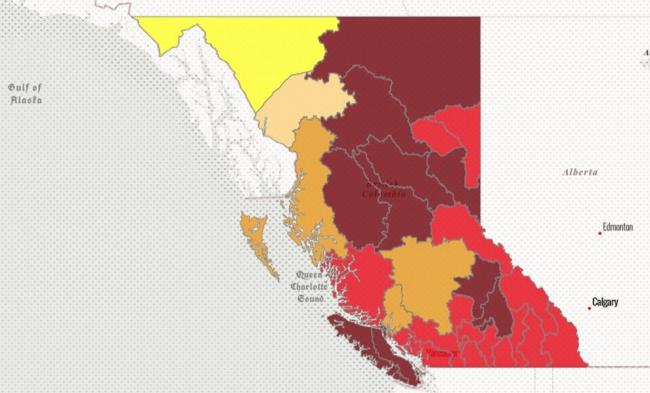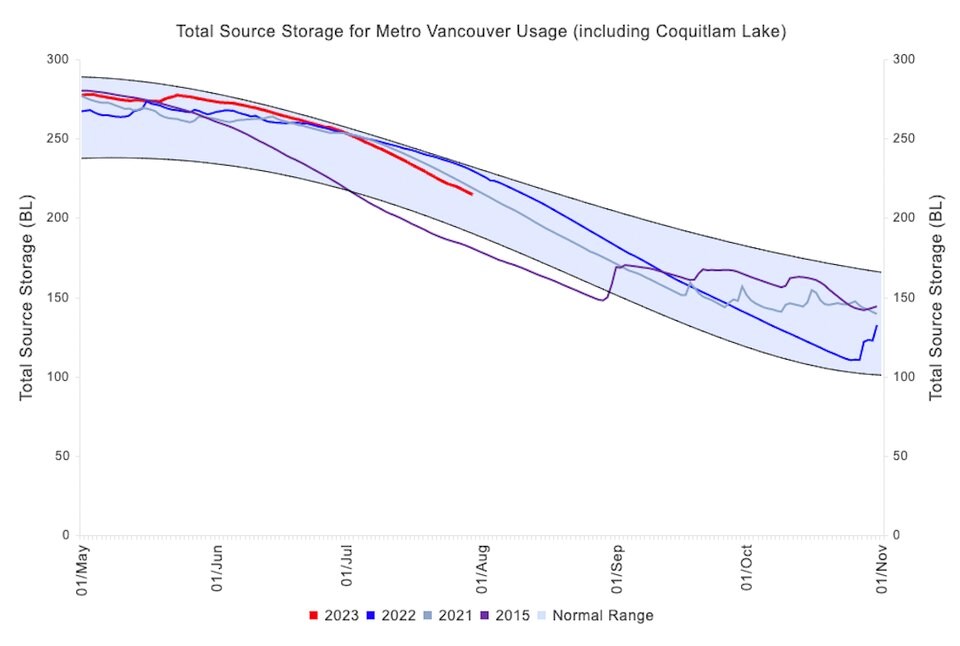Articles Menu

Aug. 5, 2023
More than 80 per cent of B.C.’s river systems face high to extreme drought conditions.
The figure, reported Aug. 3 on the B.C.’s government’s drought portal, comes as several regions of the province brace for deepening drought conditions.
“The reality is that we have been below average rainfall for most of the last 14 months,” said John Richardson, a professor at the University of British Columbia’s Department of Forest and Conservation Sciences.
“We don't know how long it has to last.”
As the drought conditions worsen, B.C.’s most destructive wildfire season on record continues to threaten communities across the province. By Friday afternoon, the BC Wildfire Service reported 352 wildfires burning across the province.
Several evacuation orders remained in place across B.C, including around the Downton Lake fire north of Pemberton, which burned five homes earlier this week, and around the East Adams Lake fire, northeast of Kamloops.
Canada’s fire weather index, which Natural Resources Canada uses as a “general index of fire danger,” sat at high to extreme levels across much of B.C.’s southern Interior and South Coast Friday.
“With drought conditions, in terms of precipitation, we need a lot more,” said Derek Lee, a meteorologist with Environment and Climate Change Canada. “In terms of wildfire activity, there’s precipitation coming to parts of the Interior. But we can also get more lightning with that.”
On the coast, a multi-season streak of dry, hot weather pushed Metro Vancouver to enact Level 2 watering restrictions Friday for the first time since 2015. The restrictions, which came into effect Aug. 4, prohibits all lawn watering for the region’s 2.8 million residents.
Vegetable gardens, trees, shrubs and flowers can be watered at any time by hand, or using soaker hoses or drip irrigation systems. Sprinklers can only be turned on between 5 a.m. and 9 a.m.
The restrictions do not apply to sources of water outside the regional and municipal drinking water supply system, such as recycled rain or grey water. Under stage 2 restrictions, each violation can lead to a $500 fine.
While current water levels in Metro Vancouver’s three reservoirs have yet to dip below 2015 levels, Richardson says 2022 presented another dangerous scenario — drought conditions lasting deep into the fall and even early winter.
“Last year was kind of a wake up that, you know, this could last a lot longer than we think,” he said.

According to his calculations, Richardson said the outdoor watering restrictions imposed by Metro Vancouver Friday would probably only make a five per cent difference in consumption. To put a real dent in water use, individuals will need to start making smart choices as they go about their day, he said.
“We know that water is getting more and more scarce, and we really don't have very many levers that the policymakers can pull,” said Richardson.
“They can make you take shorter showers or flush the toilet less often.”
For every minute someone takes a shower, almost 20 litres of water pour down the drain. Richardson said if everyone shortened their showers by a minute or two, it could potentially save more water than restrictions on outdoor sprinklers.
“People in the Metro Vancouver region and Victoria really need to be thinking, 'We've got this finite amount of water available. We've all got to share it,'” he said.
Richardson said water levels are concerning for people on the Gulf Islands and east coast of Vancouver Island, where many rely on wells to feed their taps.
Drought levels are also at their most extreme level in the South and North Thompson, as well as large parts of central and northeast B.C.
Water levels are so low in so many rivers across the province, Richardson says there’s a growing concern over impacts to wildlife.
In the more than 80 per cent of the province where Level 4 and 5 drought levels dominate, adverse impacts to people, the economy and wildlife is considered “likely” to “almost certain.”
Richardson says he's worried about how returning sockeye salmon will cope when they start spawning later this month.
“A small volume of water heats up faster than a big volume of water,” Richardson said.
“When the salmon start coming back in about a week, there's going to be nowhere for the salmon to go because the streams are so low.”
The dry conditions are also creating dangerous feedback loops in local urban forests. Earlier this week, the Vancouver Board of Parks and Recreation urged visitors to Stanley Park, the city’s most iconic, to exercise extra vigilance due to extreme fire risk made worse by an ongoing looper moth infestation.
The infestation has infected 20 per cent of the park’s trees, feasting on hemlocks and Douglas firs. Typical outbreaks last up to four years, but warmer conditions brought on by climate change have "prolonged their lifespans, allowing them to inflict a more severe impact on local trees,” said the park board Tuesday.
Persistent drought conditions in summer and harsh winters have only added extra stress to the park's trees, stated the board.
In a vicious loop, that's left them more vulnerable to insect infestations.
[Top map: Level 4 and 5 (high to extreme) drought conditions impacted more than 80% of B.C.'s river basins as of Aug. 4, 2023.B.C. government]